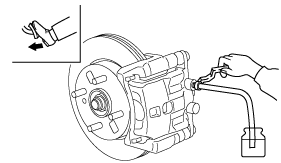 |
AIR BLEEDING
id041100187700
1. Remove the bleeder cap on the brake caliper or wheel cylinder, and attach a vinyl tube to the bleeder screw.
2. Place the other end of the vinyl tube in a clear container and fill the container with fluid during air bleeding.
3. Working with two people, one should pump the brake pedal several times and depress and hold the pedal down.
4. While one technician depresses the brake pedal, another technician loosens the bleeder screw using any commercially available flare nut wrench, drain out any fluid containing air bubbles, and then tighten the bleeder screw.
adejjw00000874
|
5. Repeat Steps 3 and 4 until no air bubbles are seen.
6. Perform air bleeding in the order of the procedure described above for all brake calipers or wheel cylinders.
7. After air bleeding, inspect the following: